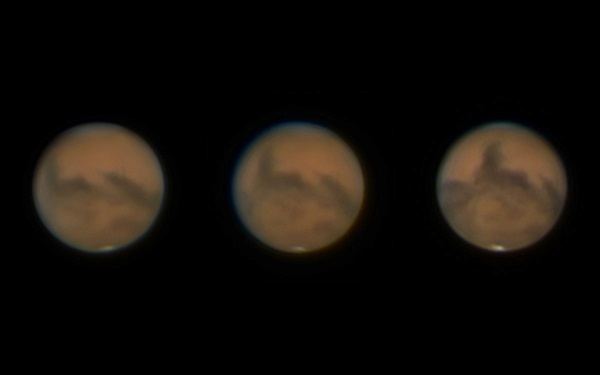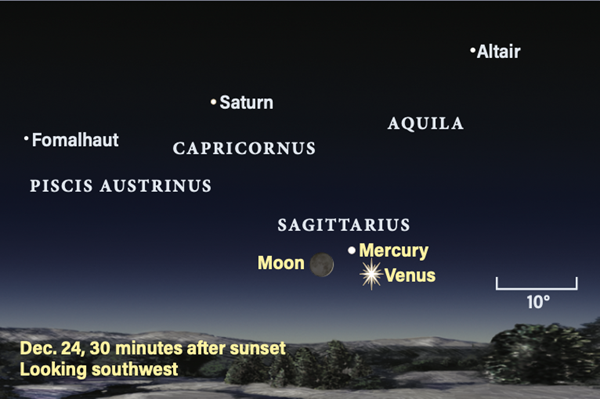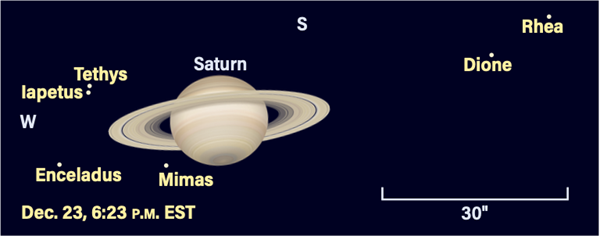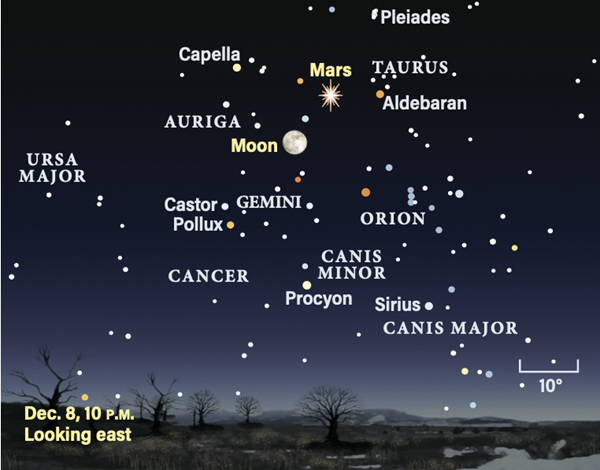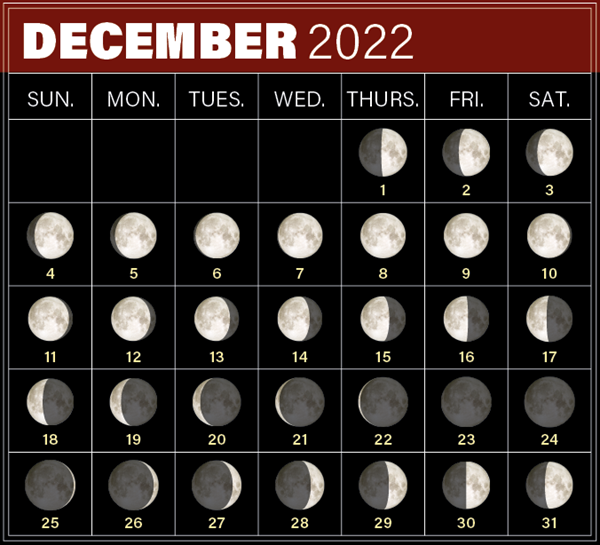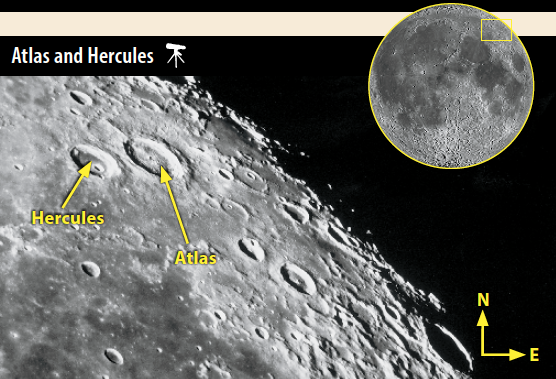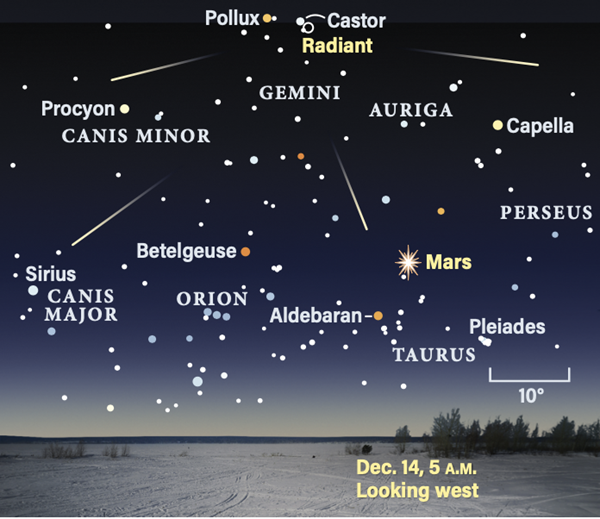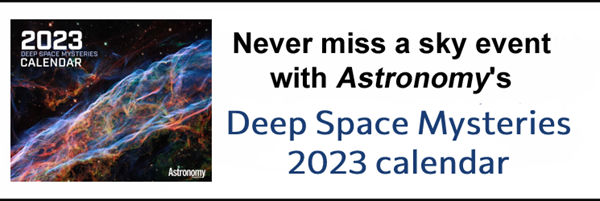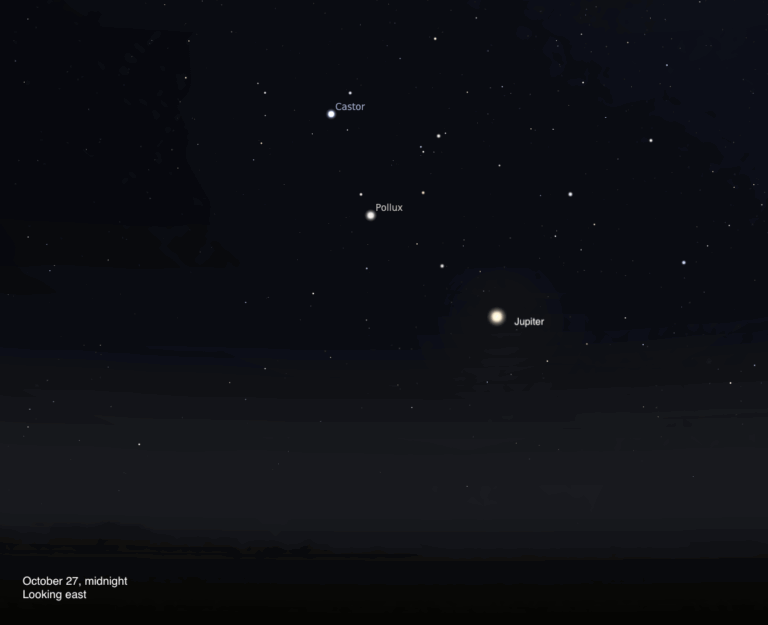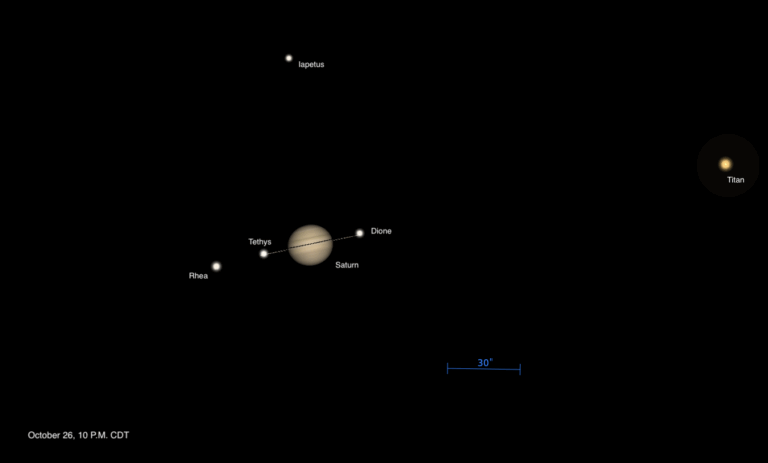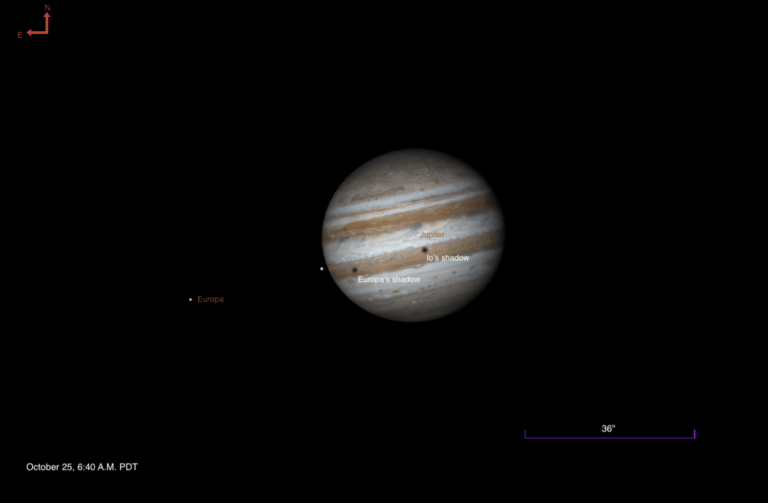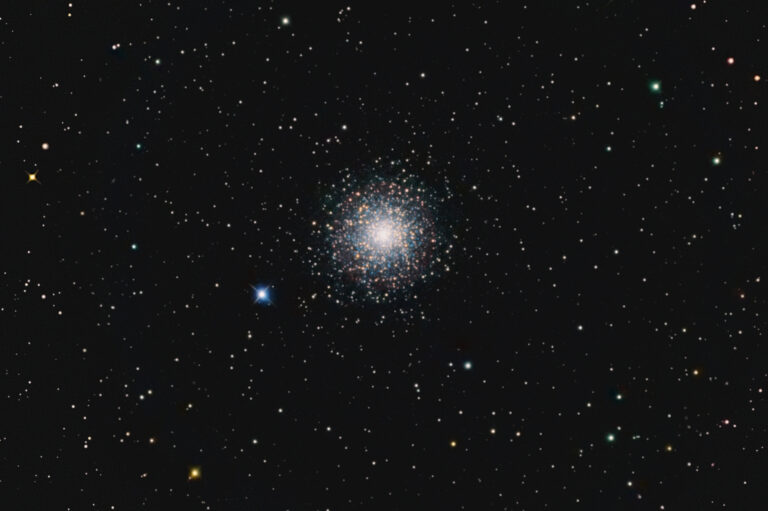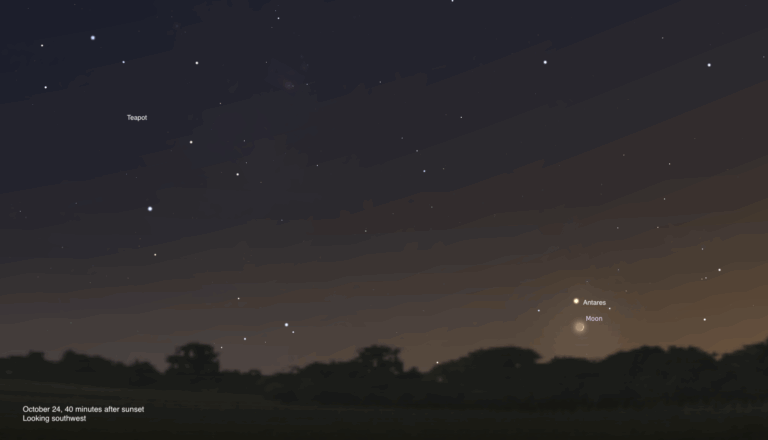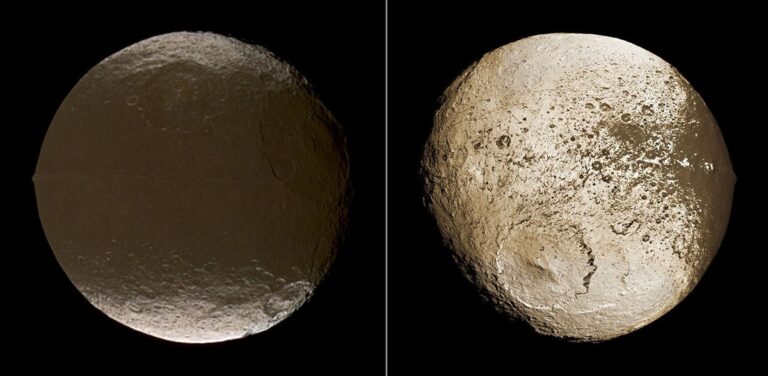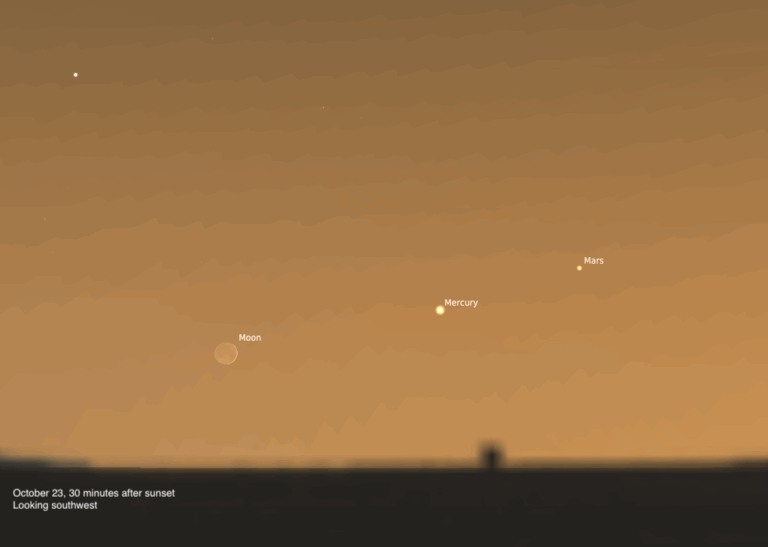Key Takeaways:
This month, all five naked-eye planets are visible in the evening sky soon after sunset. Mars grabs the most attention, reaching its most favorable Northern Hemisphere opposition in years. It’s even occulted by a bright Full Moon for parts of the U.S. Mercury and Venus make a fine pair after sunset, low in the southwest. It’s also your last chance to grab a good view of Saturn before it sets early in the evening. Jupiter dominates the southern sky after dark. And both Uranus and Neptune wander among fainter stars but are easy enough targets for binoculars or small scopes.
We’ll begin our tour with Mercury and Venus. Both planets reappear from behind the Sun and start the month still deep in twilight. They climb higher each day, moving in tandem as December progresses.
On Dec. 1, the duo sets within 38 minutes of the Sun. Venus is relatively easy to spot at magnitude –3.9, but it’s less than 1° high 30 minutes after sunset. Mercury stands 3° east of Venus, shining at magnitude –0.6.
On Dec. 8, Venus is 1.5° high and Mercury is 2° higher 30 minutes after sunset, making them easier to observe in twilight. Follow the pair as their visibility increases into the third week of the month.
On Dec. 21, Mercury reaches greatest elongation 20° from the Sun and is 8° high half an hour after sunset. Venus stands 5° away and is 4.5° high. Mercury has dimmed to magnitude –0.5; it reaches magnitude 0 by the 27th. On Dec. 24, a lovely crescent Moon joins the pair of planets in the evening sky. Look southwest 30 minutes after sunset: The Moon stands just under 5° from Mercury and 7° from Venus, forming a nice triangle.
Venus continues pulling away from the Sun as Mercury stalls. The planets appear closest the evening of Dec. 28, only 1.5° apart. By New Year’s Eve, Mercury is 4° west of Venus and has faded to magnitude 1.3, making it hard to spot. Mercury is moving toward its next inferior conjunction in the first week of the new year.
Through a telescope, Venus changes very little during December, from 99 percent to 96 percent lit. It spans 10″ all month. Mercury, on the other hand, changes from a 93-percent-lit disk spanning 5″ to 17 percent lit and 9″ wide.
Saturn is over 30° high in the south at dusk in early December. But catch it early, as the ringed planet sets by 10 P.M. local time on Dec. 1 and at 8 P.M. by Dec. 31. Saturn lies in eastern Capricornus and starts the month at magnitude 0.7, dropping to magnitude 0.8 by the 23rd. Its disk spans 16″ and the rings stretch a majestic 36″.
The rings’ apparent tilt to our line of sight drops below 14° late in December. A waxing crescent Moon stands 5° southeast of the planet on Dec. 26.
Titan, Saturn’s largest moon, is magnitude 8.5 — an easy target for small scopes. Find it north of Saturn Dec. 10 and 26, and due south Dec. 2 and 18. Fainter Tethys, Dione, and Rhea shine at magnitude 10 and lie inside Titan’s orbit. They become increasingly difficult to spot as the planet’s altitude drops later in the evening.
Look for 11th-magnitude Iapetus Dec. 22 and 23. It reaches inferior conjunction early on the 23rd and U.S. observers on the evening of the 22nd might spot the faint moon passing in front of the rings. Iapetus will appear dark against the brighter B ring. The transit is underway as darkness falls along the eastern seaboard.
On the 23rd, Iapetus passes briefly very close to Tethys, starting around 6:23 P.M. EST. The pair will appear to merge in a telescope. An hour later, as darkness falls across the Midwest, they are 3″ apart.
Brilliant Jupiter is a useful guide to find distant Neptune in Aquarius these winter evenings. In early December, Neptune stands 6° west of Jupiter. That distance extends to 8° by the 31st, due largely to Jupiter’s easterly motion along the ecliptic. Neptune shines at magnitude 7.9, requiring at least binoculars to spot.
Neptune is placed conveniently between two 7th-magnitude stars all month. The planet is retracing its steps from November as it turns eastward on Dec. 4. The two stars are the easternmost pair of a parallelogram of four stars each about 1° apart, located 5° northeast of Phi (ϕ) Aquarii and easily identified with binoculars.
Catch Neptune early, as it sets by 1 A.M. Dec. 1st and soon before 11 P.M. on the 31st. Telescopes reveal a dim bluish disk spanning 2″. The waxing crescent Moon lies 3° south of Neptune on Dec. 28.
Jupiter is hard to miss as the brightest planet in the sky after Venus sets. It’s high in Pisces in the south after sunset. The giant planet dims from magnitude –2.6 to –2.4 during the month. It’s moving east, deeper into Pisces and away from Aquarius.
Jupiter’s disk slims from 43″ to 39″, but remains an impressive sight with a wealth of atmospheric details. Begin observing Jupiter in late twilight for the best views, when its brilliance is tempered by the brighter sky and the dark pair of equatorial belts jump out. Finer details appear with patient attention. Every other night or so, the Great Red Spot makes a grand appearance.
Io, Europa, Ganymede, and Callisto regularly change position and transit Jupiter, casting their accompanying shadows. Io starts the month with a transit Dec. 1 at 8:25 P.M. EST. Its shadow follows 77 minutes later. Watch as Jupiter sinks in the west; Io leaves the disk at 10:39 P.M. EST, followed by the shadow’s egress at 11:54 P.M. EST. The event repeats the evening of Dec. 8, beginning at 10:19 P.M. EST.
Io and Europa put on a show Dec. 9, starting as Europa passes behind the planet’s western limb at 10:43 P.M. EST. After Europa disappears, look to the eastern limb to watch Io come out of eclipse about 25″ from the planet at 11:01 P.M. EST.
Callisto skims due south of Jupiter early on the evening of Dec. 13. Its orbital plane is such that the moon misses transiting or being eclipsed, but this pass is really close to a transit. Can you make out any dark space between the planet and moon?
Dec. 15 finds the huge shadow of Ganymede transiting Jupiter. It shows up on the southern temperate belt starting at 7:41 P.M. EST, but the shadow is so big that you may see it begin to appear a few minutes earlier. The shadow takes nearly two hours and 40 minutes to transit. And you can round out the year by observing the Dec. 29 transit of Ganymede starting at 10:11 P.M. EST and lasting nearly three hours. The Royal Astronomical Society of Canada’s Observer’s Handbook gives a complete list of events.
Uranus lies in southern Aries as an easy binocular target at magnitude 5.7. It’s visible all night and is highest in the hour or two before local midnight. Its 4″-wide bluish disk is a challenge in a telescope.
Uranus lies about 6° north-northeast of Mu (μ) Ceti. The easiest way to find it is to look north of Mu for 5th-magnitude Sigma (σ) Arietis, followed 3° farther along the same line by Rho (ρ) Arietis. Uranus starts the month midway between these two stars, moving slowly southwest and passing 1° due north of Sigma on Dec. 13. Both fit easily inside the field of view of 7×50 binoculars or a low-power telescope. That same night, Pi (≠) Arietis stands 1.5° northwest of Uranus.
Mars reaches its spectacular opposition Dec. 8 and is visible all night. Located in Taurus, the Red Planet stands 9.5° from Aldebaran that night. Mid-latitude observers in the Northern Hemisphere see Mars crest at more than 70° high — its best altitude for years. The Red Planet glows at magnitude –1.9 the first week of December and dims to –1.3 by the 31st.
In a dramatic opposition preshow, the Full Moon occults Mars Dec. 7, except for observers located along the East and Gulf coasts. The moment of disappearance depends on your location, but in the central U.S., Mars disappears around 9 P.M. CST and reappears about an hour later. You can visit
www.lunar-occultations.com/iota/planets/1208mars.htm for the times from your city.
Take advantage of telescopic views of the Red Planet in December’s first week, when the disk spans 17″. Mars reached its closest point to Earth Nov. 30, when it sat 50.6 million miles away. The planet now recedes quickly and slims to 15″ by the end of the month.
Mars’ 24.6-hour rotation period places features some 10° farther east when observed at the same time each night. Consequently, Mars appears to rotate backward from night to night. Adjust your observing time to catch the features listed here on different dates or times. In the hours around local midnight, the following features face Earth (for mid-U.S. locations): Dec. 1: Syrtis Major and Hellas; Dec. 10: Mare Cimmerium and Elysium; Dec. 17: Mare Sirenum and Olympus Mons; Dec. 23: Tharsis Ridge, Solis Lacus, and Valles Marineris; Dec. 30: Solis Lacus, Valles Marineris, Mare Erythraeum, and Sinus Meridiani. Mars is approaching the end of northern winter and the north polar cap has developed a darkened north polar hood (NPH), caused by clouds. Watch for changes in the NPH as December progresses and the white polar cap emerges.
If you’ve been practicing high-speed video capture of Mars over the past few months, December’s first week is the peak time to capitalize on Mars at its best. You’ll need extra hard drives to store all your frames from the long nights!
Rising Moon: Look into darkness!
During your first look at the Moon through a telescope, chances are it was painted chockablock in fantastic craters all along the day-night terminator line, like it is this first week of December. The striking 3D effect is thanks to the shadows cast by mountain ranges, hills, scarps, ridges, and crater rims.
Specifically on the 1st, the Apennine mountain range arcs north of the equator, not quite cradling the perfectly circular Eratosthenes, whose ragged rim projects spiky shadows onto its smooth lava-filled floor and central peak, and even longer spikes into the darkness to the west. You can see where artists of science-fiction stories were inspired to paint fantastic landscapes. But centuries before, Galileo knew that under a low Sun angle, even the gentlest of hills throw pointy shadows.
A solitary Mons Piton sprouts above the wrinkled sea of Mare Imbrium. The large elliptical Plato to the north is startling — watch how its shadows shrink in the next couple of hours.
Over the course of the next few nights, the Sun gradually illuminates Mare Imbrium. No one realized that it was an enormous impact basin until we got our first orbital view of Mare Orientale. Then the isolated mountains of Piton and neighboring Pico suddenly fit the picture; they are simply the tallest peaks of an entire ring, most of which is submerged under the lava that welled up from below long after the basin was first formed.
Jump halfway from the equator to the south pole to find the Straight Wall painting a black scratch across the surface. Return on the 30th to watch its shadow slowly break away from the terminator as the Moon rotates gracefully toward the Sun. By the next night, the scarp casts but a thin black line.
Meteor Watch: The earlier the better
Two major meteor showers occur in December. The Geminids are active from Dec. 4 to 17, peaking Dec. 14. Unfortunately, a bright gibbous Moon in the morning interferes with this year’s peak. Try observing earlier in the shower’s range: Although rates are lower, dark skies after midnight will show fainter Geminids and you might catch the rare bright meteor showing off early.
The second shower of the month is very favorable, its peak coinciding with the Dec. 23 New Moon. The Ursids are active between Dec. 17 and 26. With the radiant visible all night, conditions are ideal. The Ursids have produced outbursts above the normal zenithal hourly rate of 10 meteors per hour, such as in 1945, 1982, 1986, and 2014. While no outburst is expected this year, it’s still worth watching the skies later this month.
Comet Search: Transients on top
Next month, we’ll fly with Comet C/2022 E3 (ZTF) across the northern sky. Technically, it is the brightest comet this month at magnitude 8 to 9. It’s riding high before dawn but if you’re quick, you can catch it as evening twilight ends, setting in the northwest between Delta (δ) and Epsilon (ε) Coronae Borealis. Imagers will find the inner region glowing green.
A reliable target for the entire night this month is C/2020 V2 (ZTF). Somewhat fainter at 10th magnitude, this dusky snowball drifts quickly on the Capella side (southwest) of Polaris. German equatorial mounts will find tracking challenging so close to the pole, while Dobsonian star-hoppers will only find it easy after the 17th, when the comet is less than 5° from the pole star.
Under a dark sky, the nearby star cluster NGC 188 is easy pickings for an 8-inch scope. Since you’re already pointed north, skip down to the magnificent pair M81 and M82, and compare their companion 10th-magnitude elliptical galaxy NGC 3077 to the comet. With patience and powers of 150x or more, you can eke out the differences in shape and intensity.
Locating Asteroids: Hanging with the Demon
Asteroid 4 Vesta may lie at the top of the brightness list this month, but it floats across the nondescript, semi-uniform ocean of southern Aquarius, hard to pick out from the suburbs. On the other hand, 324 Bamberga lies near 2nd-magnitude Algol, named the Demon Star because ancient skywatchers noticed that it varies in brightness, unlike the other “fixed” stars. With just your eyes, watch Algol fade to magnitude 3.4 and recover to 2.1 in less than three days. It’s astrophysics in action, caused by the same transit trait we use to find exoplanets.
Having just passed opposition and its closest point to Earth in November, Bamberga slowly fades from magnitude 9 to 10, so a 4-inch scope is needed to nail it in the suburbs. The dust and gas so famously lit up by the Pleiades star cluster extend across this section of the Perseus Arm of our Milky Way Galaxy, suppressing background stars and leaving few competitors to distract you. On the 9th, 12th, and 16th, you should be able to notice Bamberga shift against the background stars in a two- or three-hour session.
Spanning 140 miles, Bamberga is one of the main belt’s top 20 players in terms of size. Its eccentric orbit closes in on Mars and reaches two-thirds of the way to Jupiter. When it sits out near the latter in 2025, it will hit a feeble maximum magnitude of 11.9.

